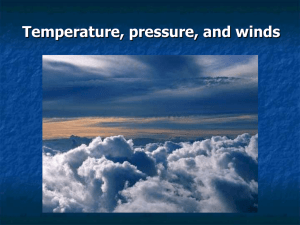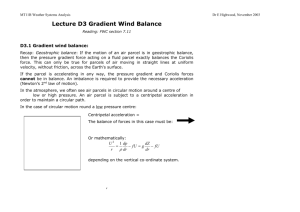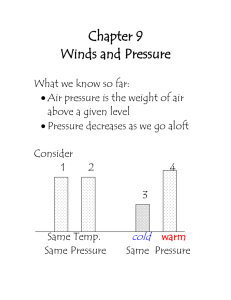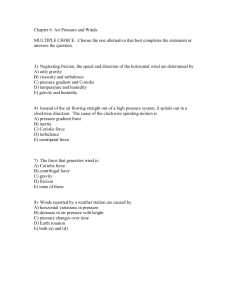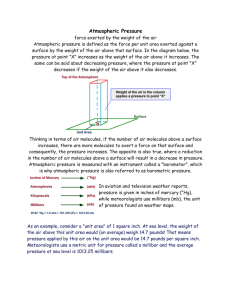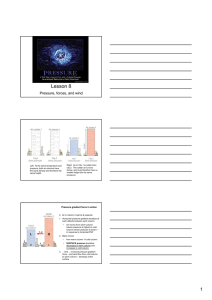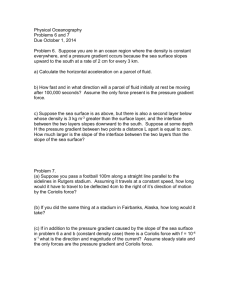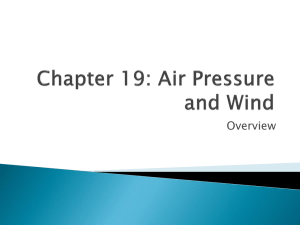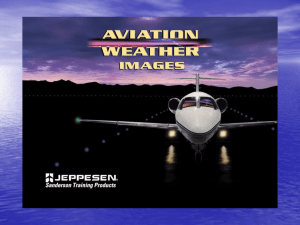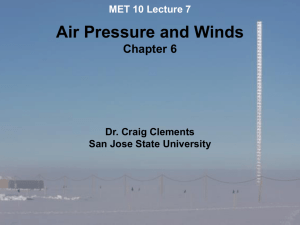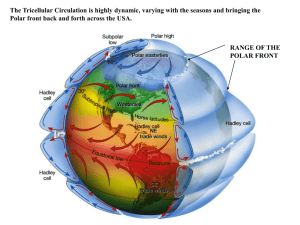What set the atmosphere in motion?
advertisement
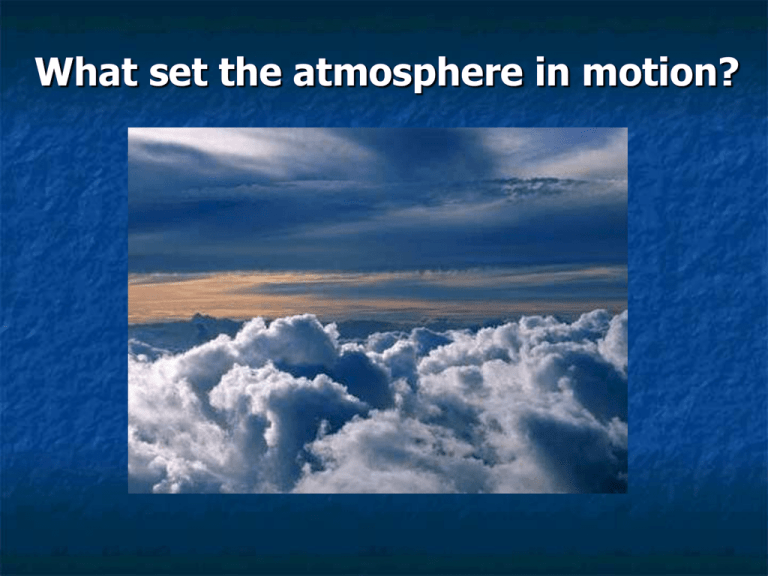
What set the atmosphere in motion? Review of last lecture Thickness of the atmosphere: less than 2% of Earth’s thickness Definition of temperature and its unit. Four layers of the atmosphere, what separate them? Definition of pressure and its unit. Definition of pressure gradient. Pressure gradient sets the air in motion. Equation of state (Relationship between P, ρ, and T) Vertical Pressure Distribution. How does pressure change with height? What is the hydrostatic equilibrium? Horizontal Pressure Distribution. Most common atmospheric circulation structure The most common atmospheric circulation structure H L Cooling or No Heating Heating H L Imbalance of heating Imbalance of temperature Imbalance of pressure Wind Horizontal Pressure Gradients and wind The pressure gradient force initiates movement of atmospheric mass, wind, from areas of higher to areas of lower pressure Horizontal wind speeds are a function of the strength of the pressure gradient Pressure and winds plotted on same chart Notice the strong winds in Ohio – due to tight pressure gradient Forces Affecting the Speed and Direction of the Wind Horizontal pressure gradients responsible for wind generation Three factors affect wind speed and/or direction (velocity): 1. Pressure Gradient Force (PGF) 2. Coriolis Effect (CE) 3. Friction Force (FF) DV = PGF + CE + FF Dt 1. Pressure Gradient Force (PGF) • pressure gradient: high pressure low pressure • pressure differences exits due to unequal heating of Earth’s surface • spacing between isobars indicates intensity of gradient • flow is perpendicular to isobars Video: Coriolis effect http://www.youtube.com/watch?v=aeY9tY9vKgs 2. The Coriolis Effect objects in the atmosphere are influenced by the Earth’s rotation Rotation of Earth is counter-clockwise looking down from N. Pole. results in an ‘apparent’ deflection (relative to surface) deflection to the right in Northern Hemisphere (left in S. Hemisphere) Greatest at the poles, 0 at the equator Increases with speed of moving object and distance CE changes direction not speed Winds in the upper air: Geostrophic Balance Friction is very small in the upper air: DV = PGF + CE + FF Dt • Now the wind speed/direction is simply a balance between the PGF and CE. This is called GEOSTROPHIC BALANCE. • Upper air moving from areas of higher to areas of lower pressure undergo Coriolis deflection • Air will eventually flow parallel to height contours as the pressure gradient force balances with the Coriolis force Winds near the surface The third term (friction) must be considered: DV = PGF + CE + FF Dt Friction slows down wind speed and reduces Coriolis deflection Friction is important for air within ~1.5 km of the surface (the socalled planetary boundary layer). It varies with surface texture, wind speed, time of day/year and atmospheric conditions. Friction above 1.5 km is often small (often called the free atmosphere), except over regions with storms and gravity waves. Effect of frictional force Upper air w/out Friction (geostrophic balance) Near surface w/ Friction Clockwise airflow in NH (opposite in SH) Counterclockwise in NH (opposite in Characterized by descending/converging SH)characterized by air which warms creating clear skies ascending/diverging air which cools to Cyclones, Anticyclones, Troughs and Ridges Upper air: isobars usually not closed off Troughs (low pressure areas) Ridges (high pressure areas) Near surface: isobars usually closed off due to surface friction Cyclones (Low pressure areas) Anticyclones (High pressure areas) Summary Know 3 Forces that affect wind speed /direction Especially work on Coriolis force, as this is the hardest to understand. Which direction is air deflected to by Coriolis force? What is the geostrophic balance? At which level is it valid? Difference between upper level and surface winds Does cyclones correspond to high or low surface pressure? Is the air moving clockwise or counterclockwise around them? How about anticyclones?
